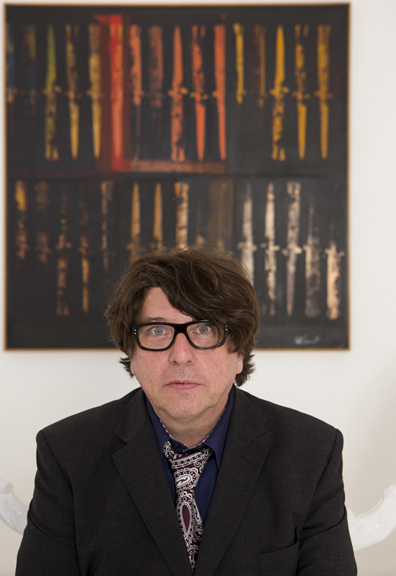
Echo & The Bunnymen’s Will Sergeant
An Artist Slays His Own Worst Enemy
May 22, 2012
Echo & the Bunnymen
Photography by David Studarus
![]()
When historians record his contributions to society, Will Sergeant is well aware that his role as a member of Echo & The Bunnymen will probably always be part of the headline. He jokes about weathering the promotional gauntlet with his band, noting how he used to pull pranks that included changing his glasses several times during video interviews to ruin the continuity.
But now at 54, the musician/artist finds himself eager to speak about his new endeavor: life as a mixed-media visual artist. After years of experimenting with photography, screen-printing, and acrylics—even serving as an artist in residence at Liverpool School of Art and Design—he has just opened first official exhibition. Called My Own Worst Enemy, the show runs from May 18 through June 16 at Substrate Fine Art Gallery in Los Angeles, CA. It’s a big step for Sergeant, who admits his finished pieces used to end up crumpled in the back of drawers.
Under the Radar joined Sergeant during the gallery prep. There, the artist stepped away from supervising the process to talk about making art for yourself and others, the inspiration he draws from music, and the intersection between the two art forms.
In your bio, you listed your artwork all the way back to the Weird as Fish tape you created in the early 1970s. Were you aware of the idea of sound art at that time?
I think it was starting to filter in a little bit. I bought Metal Machine Music, Lou Reed’s album. I bought that on import when it was really expensive, I think it was fourteen quid or something. It was ridiculously expensive. I was desperately trying to understand it. I could see patterns in it. You know the way your brain can unravel things, like when you see experimental audio research. Things like that. When you’re listening to it, you’d think “Oh that’s just a load of noise.” And then your brain starts finding patterns. I think I found patterns in that. I used to play it all the time. I used to have it on and the neighbors would go berserk. They hated it. They were always knocking on the door.
I saw Captain Beefheart’s paintings in about 1972. To me art is a complete continuation from music. It’s the same mind; it’s the same mindset and thoughts.
Finding repeating patterns?
It’s much more like improvisation.
When I play the guitar, I’m trying to think of something. I don’t even think about it, I just start doing stuff. Then all of a sudden, something will happen. It’s alright, and then I’ll keep going with that. It’s the same with painting. I’ll do something with that. And then I’ll expand it.
I don’t really like to think about it too much, in case it kills it. I can’t say, “I’ve got to do it this way or I’ve got to do it that way.” I like the idea of being free. It’s all about freedom verses restriction. That’s the whole thing as far as I’m concerned.
I was told recently that all artists have reoccurring themes. It’s funny, because looking at your art; you have so many different themes going on.
Well, they’re sort of linked in a weird way. I feel like an elastic band stretched back. I didn’t really know how to do it, or whether I should do it. Now I’ve been released and it’s like, “pow!” Things are coming quick. I’ve learned how to do screen printing in the art school in Liverpool. I’m just experimenting. That’s what I did with the Weird as Fish thing. It was just an experiment. I did that with another album in 1982 called Grind. I heard it at my friend’s house the other day in Los Angeles, and he played it, on vinyl. I haven’t heard it for years, and I just can’t believe I did it. It’s so modern. [laughs] Do you know what I mean? But weirdly experimental. I had no equipment. There were no sequencers or anything like that. I couldn’t play keyboards.
That would be really interesting to hear again now. I was listening to the Can reissues recently, and I felt the same way, it’s something that’s out of time and place.
I would listen to that today. I love Can.
So it was in the late 2000s when you started working on visual art seriously?
Yeah. I just started buying canvases. I just started from there really. It was like I was possessed. I was doing it on the kitchen table. There was paintings and paint everywhere. I’ve moved out since then.
Was there a catalyst, or was it just a decision that you could not not make art?
I’ve always been doing things that I didn’t really realize was art. I was doing the sound art thing, and I’ve done more formal things. I did electronica in Austria, which was as sound art kind of thing. I’ve done some things in Liverpool and Manchester. Mainly autoharps and things like that. Omnichords. I get my drones going on omnichords, and then I mess around with them.
When it comes to the visual side of your art, it seems like the painting came first. What inspired you to learn screen-printing?
I’m a bit impatient. I like things to be quick. That’s why I don’t use oil paints at all. I tried to use it, but they just take forever to dry. I just think, I want to get on with stuff. I’ll probably do some oil paint soon. I’ve got room, I’ve got a new workshop, so I can keep it going. Just when I’m in between acrylics. Something like that. It’s quick, screen-printing. Also, every time you do it, you’re not quite sure how it’s going to turn out. There’s anomalies that get in there. Happy accidents where it doesn’t quite work. There are dodgy bits. I was in the art school for ages, and every time I screen-printed I’d do a little bit more.
Is that something you feel comfortable doing in your music as well? Embracing those little imperfections?
You know what perfect music is? Boring. It’s muzak. If you have a band you want them to be alive, don’t you? I suppose it’s the same idea. It does come from the same place, I think. I don’t really want to delve in too much. But in my head, they’ve both got a thing to them. A mental torment. [laughs]
Are there any pieces that you feel comfortable talking about specifically?
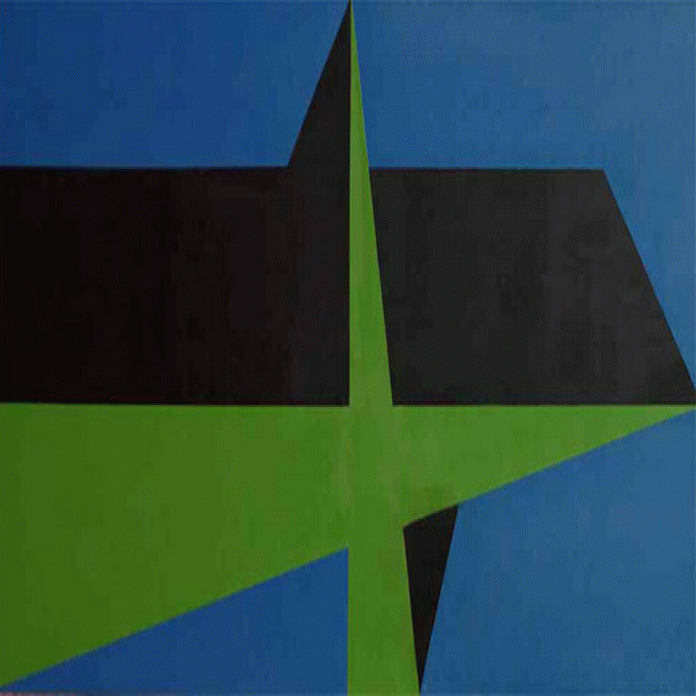
That one there—that’s 21st Century Fallen. That’s meant to be the distorted cross. It’s meant to represent civilization, and it’s fell over. It’s over. It’s distorted. The perspective is all wrong. It’s meant to be saying, “it’s the 21 century, and we’re supposed to have sorted out all the problems by now.” There’s still people getting killed all over the place, there’s more wars then there have ever been. That’s what it is, 21st Century Fallen. It’s over, already.
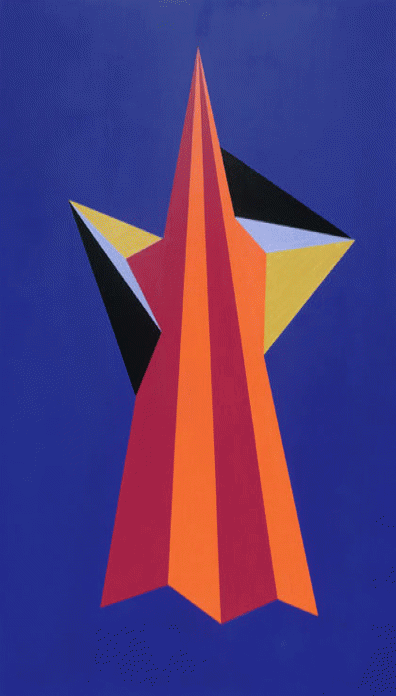
Then I did that one. And I was going to call that 21st Century Risen. At the start I thought “I’m going to make it all colorful and brash.” When I was doing it, I thought “Nah. It’s not going to rise, forget it.” So I just called it Dream On instead.
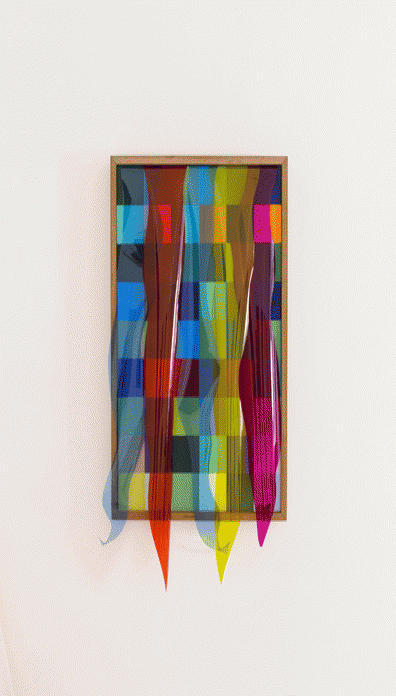
That one’s more of a mental torment thing.
I like the mixed media on that.
That one, it took me ages to do that one. All those squares. I was on the kitchen table. Everyone was going nuts in our house. I did it, and then I went to the Tate Gallery in Liverpool, and I saw a bloody Gerhard Richter and it was pretty much exactly the same! [laughs] I thought, “Shit! It took me ten weeks to do those squares perfectly!” So I did something else with it. But it’s meant to be a mental torment. It’s all about how your mind is your own worst enemy.
And that’s where the title of the exhibition comes from?
Yeah. We’ve done some mad stuff in our day. We pissed off a lot of people. We are our own worst enemies.
Is that something you’ve feel like you’ve overcome a bit as time has gone by?
Still working on it. [laughs] I don’t know. I’ve always liked experimenting. That’s probably why there are so many different things going on in my art. I’ve already got other ideas that I want to do. Since I discovered Gerhard Richter does stuff like that, I’ve been looking at his stuff. He does a lot of stuff that’s similar. But he does a lot of different things. If he can do it, I can do it. The whole thing with artists is that there’s no rules, is there.
Was art something that was emphasized growing up for you?
No. I went to an ordinary school. You were just factory fodder. You were lucky if you got a job in Fords. There was an art teacher in the school, but he didn’t really give a shit. Art to them is just an easy lesson. The kids could just play with paints and get on with stuff. We were never taught about any other artists or anything like that. Nothing. Never had another artist mentioned to us the entire time we were there. There was just some paper and paints, and get on with it. We all saw it as a messing around kind of lesson, fighting and throwing things at each other. So there was nothing to inspire.
But I always knew that I liked art. I like galleries and I liked the sort of feeling inside an art galley. The stillness, the reverence. The paintings. I loved that atmosphere. I don’t know; it’s just kind of grown.
And album art has been a big inspiration as well.
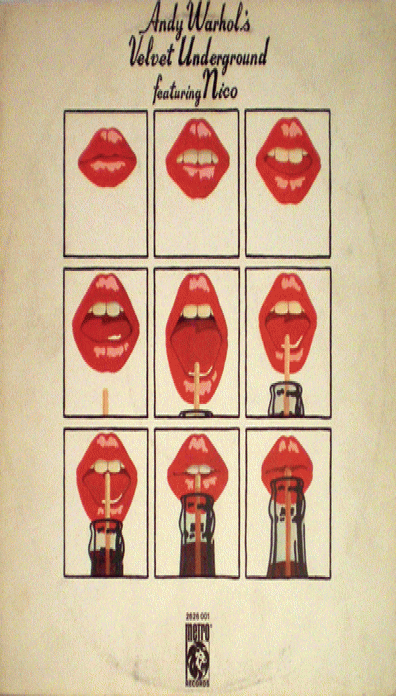
Yeah. I love The Velvet Underground. The Bunnymen are massively inspired by The Velvet Underground. My first Velvet Underground record, I bought it because of the cover. I had never even heard of them. It wasn’t the banana one, it was the double one. The Velvet Underground and Nico. The one with the lips on it, and the Coke bottle on the inside. I just liked that cover. That was a happy accident, because that led me to all kinds of other things. Even in school I did a talk on The Velvet Underground, you know, when you have to do a show-and-tell thing.
How old were you at the time?
Fifteen or something like that.
What was the response from your classmates?
I played “European Son” and I played “Pale Blue Eyes.” They liked “Pale Blue Eyes.” It’s a nice little song, isn’t it?
I loved the sound of those records, they way that they were recorded a bit shitty. Everything’s a bit distorted. It’s just intriguing, you know? It seemed like all the bands that I liked were from an art school background. I would have loved to have gone to art school. But where I was from it was “get a job, work at a factory.” It was only because of music that I managed to escape that sort of thing.
But yeah, all the bands that I liked had an art school background. I didn’t really put it together until a few years ago. There must be something in that, you know? All bands are seen as kind of artsy. Punk took loads of stuff from the Dada movement, all the cut up letting and all that stuff. So in 2002 I got invited to go to the university. I did a Dada website thing.
You also had a few pieces in the Mr. Brainwash show, right?
The great thing about Brainwash is that he opened it up to anybody. I thought that was really cool. What other artist does that? I’ve got an exhibition, and I’ve got all this spare space. Anyone can come in and fill it up. So it was a happy accident that I got stuff in there. I just pasted it up. It’s just an interesting story, isn’t it?
I don’t think many people noticed. I think probably a few. But I don’t think it lead to this particularly. It gave me a bit of confidence.
Since you really loved those records and album art, do you feel like that’s being lost, with the shift over to digital?
Oh God, yeah. CDs and MP3s. I think it was Turkey, in Istanbul. I did an interview, and I didn’t realize it was from this company that does all the downloads. He said to me, “What do you think of all the downloads?” And I said, “I think it has reduced music to the value of toilet paper.” They were sponsoring the gig! So that didn’t go over very well. [laughs] They were expecting me to say, “Oh it’s brilliant!”
Now, people will put all their music on a phone, and then they’ll see something on YouTube of a dog skiing. “Oh I have to dump all this music off to get this crappy video on!” It’s disposable, isn’t it? It’s sickening. Young people now, that’s all they know. MP3s music, it’s got no value. You know what I mean? It’s art, but it’s so disposable now.
Do you see yourself combing your visual art and music together in the future?
I’ve done sound art that has visuals. I did a thing where I was in a gossamer tent. I had visuals projected on to the tent and the coming through to the back where I was twiddling knobs and making noises. I haven’t done that for a while. We did one in Liverpool called Mycroft’s Curious Delight. [laughs] It was a lot of sound artsy type stuff. It was good. I love visuals and music. It’s perfect, isn’t it?
When I go see a band now, I want to see something going on as well. Especially the sort of bands I like that just stand there, droning on. You want to see great visuals.
David Studarus: I know you did the drone for the Rothko show in Liverpool. How was that creating a drone for another artist? Especially one of that stature?
My friend at the art school, Professor Colin Fallows, he’s my collaborator in the sound art thing. He’s an expert. He’s opened my eyes to a lot of stuff. It was me and him who did the thing for Rothko. I said, why don’t we record six different guitars doing one note of a chord? We made this half hour kind of thing, and faded in an out each string. We just sort of thought it went with the pictures.
It was only on for one night. It wasn’t like a big “Will and Rothko, best mates” thing. You know what I mean? We just did it for this opening night thing. That was it. But it was great.
It’s funny; you don’t see many musicians exhibiting their art in a proper gallery.
Well it’s seen as a bit crap, isn’t it?
The gallery scene?
It’s a very snobby world, the gallery thing. It’s seen as a bit, “Oh yeah, he thinks he can paint. Whatever.” It’s seen as a bit cheesy. But that’s what I am, that’s what I do. If you like it, you like it, and if you don’t you don’t.
See a full gallery of Will Sergeant portraits here.
Current Issue

Issue #72
Apr 19, 2024 Issue #72 - The ‘90s Issue with The Cardigans and Thurston Moore
Most Recent
- Under the Radar Announces The ’90s Issue with The Cardigans and Thurston Moore on the Covers (News) — The Cardigans, Thurston Moore, Sonic Youth, Garbage, The Cranberries, Pavement, Lisa Loeb, Supergrass, Spiritualized, Lush, Miki Berenyi, Miki Berenyi Trio, Emma Anderson, Hatchie, Ride, Slowdive, Velocity Girl, Penelope Spheeris, Terry Gilliam, Gus Van Sant, Ron Underwood, Kula Shaker, Salad, Foals, Semisonic, The Boo Radleys, Stereo MC’s, Pale Saints, Blonde Redhead, Sleater-Kinney, Cocteau Twins, Lucy Dacus, Alex Lahey, Horsegirl, Grandaddy, alt-J, Squid, The Natvral, Wolf Alice, Jess Williamson, Sunflower Bean, Orville Peck, Joel McHale
- 10 Best Songs of the Week: Fontaines D.C., Cassandra Jenkins, Loma, John Grant, and More (News) — Songs of the Week, Fontaines D.C., Cassandra Jenkins, Loma, John Grant, Good Looks, Hana Vu, Belle and Sebastian, Yannis & The Yaw, Strand of Oaks, Home Counties
- Fresh Shares New EP ‘Merch Girl’ (News) — Fresh
- Premiere: LOVECOLOR Shares New Video for “Crazy Love” (News) — LOVECOLOR
- Final Summer (Review) — Cloud Nothings

Comments
Submit your comment
May 11th 2013
4:56am
Indeed a very nice post. I am also associated with imaginationworksla, vehicle wraps los angeles, car wraps los angeles, Banner stands los angeles. Thanks for writing such good posts and as I have subscribed to your blog, I do expect that you will be posting nice posts like this on a regular basis.